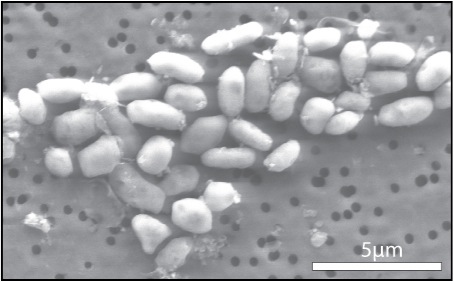 On Thursday, NASA held a press conference announcing some surprising news with implications for astrobiology. A team of scientists led by Felisa Wolfe-Simon found a form of bacteria living in Mono Lake in California, near the border with Nevada, which had the ability to process arsenic and could even integrate the normally toxic element into the normally phosphate-rich backbone of its DNA.
On Thursday, NASA held a press conference announcing some surprising news with implications for astrobiology. A team of scientists led by Felisa Wolfe-Simon found a form of bacteria living in Mono Lake in California, near the border with Nevada, which had the ability to process arsenic and could even integrate the normally toxic element into the normally phosphate-rich backbone of its DNA.
However, because of how this was announced and the complicated nature of the content of the announcement, there have been quite a few misunderstandings of the nature of the bacteria found and the implications. There are a few good posts from Ed Yong, Carl Zimmer, and P.Z. Myers detailing exactly what was found and dispelling some of the hype and myths that arose surrounding this press conference.
 For my part, what I want to focus on is the broader context of this result. I’ve often found those with an eye toward science fiction suggest the possibility of life forms arising from different building blocks that those used by terrestrial life, such as the replacement of carbon with silicon. In this case, we see a bacterium that is able to cope with the replacement of phosphorus in the form of phosphate with arsenic in the form of arsenate, which is possible because of the similar properties shared by both elements, which is reflected by their relative positions on the periodic table.
For my part, what I want to focus on is the broader context of this result. I’ve often found those with an eye toward science fiction suggest the possibility of life forms arising from different building blocks that those used by terrestrial life, such as the replacement of carbon with silicon. In this case, we see a bacterium that is able to cope with the replacement of phosphorus in the form of phosphate with arsenic in the form of arsenate, which is possible because of the similar properties shared by both elements, which is reflected by their relative positions on the periodic table.
For more terrestrial forms, the differences in behavior between arsenate and phosphate make the former toxic. However, Mono Lake’s bacteria have developed mechanisms to cope with their environment’s high arsenic levels, even to the extent that they are capable of integrating arsenate into their DNA in place of phosphate.
I am highly skeptical of the notion that a form of life would develop using silicon in the role that carbon plays in terrestrial life or that it would preferentially use arsenic in the same role that phosphorus fills in terrestrial life. Part of this skepticism, particularly with regard to carbon and silicon comes from the relative chemical properties of the elements in question, with carbon being a more versatile element than its heavier neighbor on the periodic table. However, more importantly, there a simple issue of abundance.
As you can see from this Table gathered from the Wikimedia Commons, carbon is almost 10 times more abundant than silicon in our solar system. Life tends to work with what its environment provides it (the Mono Lake bacteria are a testament to that) and so it would make sense for life to work with carbon over silicon both for its relative utility chemically and its relative abundance.
In the case of phosphorus and arsenic is even more dramatic. Phosphorus is over 1000 times more abundant in the universe than arsenic. Given its use in terrestrial life, phosphorus itself is a relatively rare element. Its heavier cousin arsenic is so rare that I have a hard time imaging that a life form dependent upon it would stand much of a chance of thriving beyond the confines of some arsenic-rich area like Mono Lake. It should be noted here that even in Mono Lake, the preference of the bacteria is for phosphate.
Ultimately, while this is an exciting discovery that tells us something about life’s resilience and adaptability, it was overhyped and it does not mean that we are likely to find an extraterrestrial civilization that uses arsenate compounds in the same way that we use phosphate.





I was watching it on Fox News; the SETI woman, whatever her name is, was entirely level-headed about the discovery, concluding it is nothing more than a local adaptation of life-as-we-know-it. Bill Nye with his fruity bow-ties was more enthusiastic, of course. I think you’ve cinched it perfectly.
On the other hand, we ought to be thankful to NASA for putting this Wolfe-Simon bozo on display. Ari Velshi could barely contain his mirth. I wonder if anyone else had the feeling they were suddenly in a SoCal preschool being read to for “story time”. Also a fine example of a certain tribe which thrives on framing life for extratribals. “This is profound.”
I have not seen any of the TV coverage of this announcement, but I do feel that NASA needs to be more scrupulous in how it announces press conferences. There was a big rumor mill among my Chinese friends that NASA had found aliens, which arose in advance of the announcement last month from Chandra that they’d nearly confirmed the observation of a black hole’s formation in a nearby galaxy.
When I saw an announcement of a press conference, this time with an astrobiology theme, I thought I might see a repeat, though this time the rumors were more prevalent among Americans. Then, of course, when the story came out, it wasn’t properly vetted and the significance and meaning of the results were badly exaggerated. I hope for better in the future.